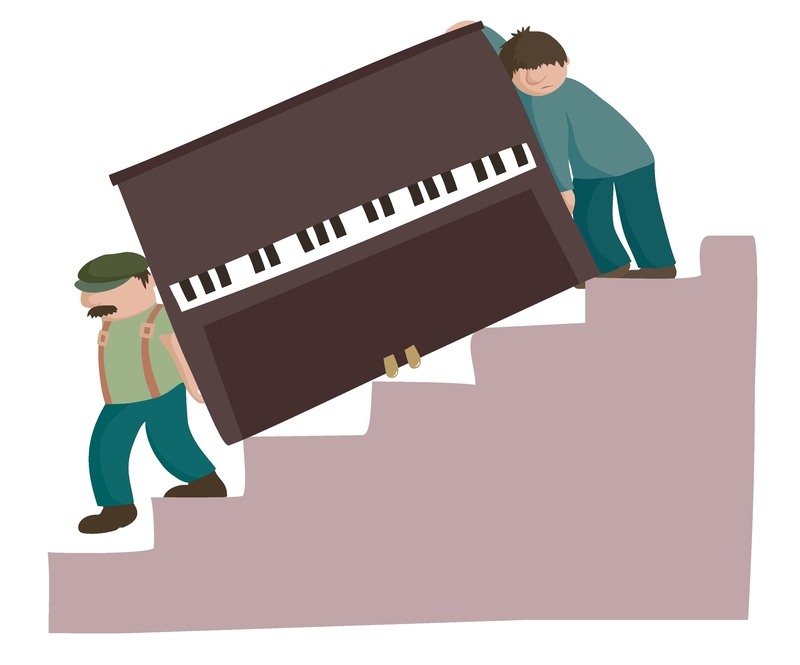How to Move a Piano Safely and Why It's Not a Task for Amateurs
A piano is more than just a musical instrument; it is a delicate, valuable, and sometimes sentimental object that demands the utmost care during any move. Whether you're shifting an upright piano to another room or relocating a grand piano across town, understanding how to move a piano safely is crucial. This article unpacks the step-by-step process, emphasizes the risks involved, and explains why moving a piano is not a task for amateurs.

Understanding the Complexity of Moving a Piano
Before delving into the logistics, it's essential to appreciate why moving a piano is an intricate process that requires expertise:
- Size and Weight: Pianos are remarkably heavy and awkwardly shaped. Upright pianos typically weigh between 300 and 800 pounds, while grand pianos can exceed 1,200 pounds.
- Delicacy of Parts: Despite their massive frames, pianos have fragile internal components--like strings, hammers, and pedals--that can be damaged if handled improperly.
- Value: Many pianos are irreplaceable antiques or expensive investments, and any mishap can result in costly repairs or devaluation.
- Risk of Injury: The challenge isn't just to the piano. Untrained movers can suffer serious injuries, especially back strains and crushed fingers or toes.
For these reasons, moving a piano is a specialized job--requiring specific skills, equipment, and knowledge that amateurs simply do not possess.
Why Hiring Professional Piano Movers is Essential
Many homeowners underestimate the challenges involved and attempt a DIY move--often leading to disastrous outcomes. Here's why professional piano movers are worth every cent:
- Specialized Equipment: Professional movers use heavy-duty piano dollies, skid boards, ramps, and brackets, designed specifically for the safe transport of pianos.
- Training and Expertise: Moving companies train their crews in proper lifting and maneuvering techniques for each piano type.
- Insurance: Reputable movers carry insurance, protecting your instrument--and your property--in the event of an accident.
- Experience with Tight Spaces: Professionals know how to navigate staircases, narrow doorways, and tight corners without causing damage.
Ultimately, hiring experts drastically reduces the risk to both your piano and your personal safety.
Common Mistakes Amateurs Make When Moving Pianos
- Improper Lifting: Attempting to lift a piano without securing the proper grip and balance can easily result in injuries and dropped instruments.
- Lack of Planning: Not mapping out the exact path or clearing obstacles increases the likelihood of bumping the piano into walls or furniture.
- Incorrect Disassembly: Some pianos require parts (like legs or pedals) to be removed before moving. Amateurs either skip this step or do it incorrectly, leading to damage.
- Insufficient Protection: Wrapping a piano with only a blanket--or worse, nothing at all--leaves it vulnerable to scratches and dents.
- Using the Wrong Equipment: Regular dollies or carts can buckle under the weight, leading to dangerous accidents.
These oversights not only jeopardize your instrument, but can also put you and your helpers at serious risk.
Step-by-Step: How to Move a Piano Safely
While it's always best to hire professionals, understanding the proper process can help you evaluate your movers or assist in a minor in-home move. Here is a detailed guide on safe piano moving:
1. Assess the Size and Type of Your Piano
- Is it a grand, baby grand, or upright piano?
- Measure and weigh your piano, and note any detachable parts.
2. Clear the Moving Path
- Sketch a floor plan to chart the path from the piano's current location to the desired spot.
- Remove rugs, furniture, and other obstacles.
- Open doors and measure their width to ensure clearance.
3. Assemble the Right Team
- Never attempt to move a piano with fewer than three strong, able-bodied adults.
- Appoint one person as team leader to coordinate actions and communications.
4. Gather Professional Moving Equipment
- Piano Dollies: For upright pianos, use a sturdy dolly. Grand pianos require a specially designed skid board (or piano board).
- Moving Blankets and Straps: These prevent damage and help secure the piano during transit.
- Work Gloves: Protect your hands and improve grip.
- Ramps: Essential for maneuvering over stairs or steps.
5. Secure and Protect the Piano
- Close and lock the keyboard lid--if the piano doesn't lock, secure it with tape to prevent accidental opening.
- Wrap the piano in thick moving blankets, taping them securely.
- If moving a grand piano, carefully detach the legs and pedals, wrapping them individually.
6. Lift Correctly and Carefully Transfer to Dolly or Skid Board
- Use the knees to lift--never your back.
- Never lift or push using the legs of the piano, which can easily snap under pressure.
- Gently tilt and slide the piano onto the dolly or skid board.
7. Navigate Stairs and Tight Turns with Extreme Caution
- Have your strongest mover at the bottom when going up or down stairs.
- Move slowly, communicate constantly, and keep the piano upright at all times.
8. Load the Piano into the Moving Vehicle Securely
- Make sure the vehicle is equipped with a ramp or lift gate.
- Keep the piano against the back wall of the truck--never on its side or back.
- Use straps to immobilize the piano, preventing any shifting during transit.
9. Unload and Reassemble
- Remove the piano the same way it was loaded, maintaining slow and controlled movements.
- Reattach any removed parts as per the manufacturer's instructions.
10. Tune the Piano After the Move
- Even the most careful move can cause a piano to go out of tune.
- Wait a few weeks for the piano to acclimate to its new location, then hire a professional tuner.
Special Considerations for Different Types of Pianos
Not all pianos are alike. Here's what to know about the two most common types:
- Upright Pianos: Easier to handle due to their upright structure, but still require careful balancing and lifting. Great care should be taken not to roll the piano across wooden floors, as its weight can scar the finish.
- Grand and Baby Grand Pianos: These require disassembly, including the removal of the legs, lyre, and pedals. They're more sensitive to tilting and should always be carried by the frame, not the legs.
The Hidden Risks of a DIY Piano Move
- Personal Injury: Every year, hundreds of people injure themselves attempting to move heavy items without proper training.
- Damage to Property: It's easy to underestimate a piano's weight and boundary, leading to holes in walls, dented floors, or shattered staircases.
- Permanent Damage to the Piano: Dropping or mishandling can cause irreparable harm to the strings, keys, or soundboard, something not always covered by homeowner's insurance.
- Voiding Warranties: Many piano manufacturers specify professional moving as a warranty requirement. DIY moves may void your warranty.
Frequently Asked Questions About Piano Moving
Do Professional Movers Tune the Piano After Delivery?
No, most piano moving companies do not tune pianos. Allow your piano to adjust to its new environment for 2-4 weeks before scheduling a professional piano tuner.
How Much Does It Cost to Move a Piano?
The cost to move a piano varies based on size, type, distance, and obstacles like stairs. Expect a range from $150 for short local moves, to $1,000 or more for specialty grand pianos over long distances.
Can I Move a Small Upright Piano Myself?
Though upright pianos may seem manageable, their awkward weight distribution makes them difficult to safely transport without experience or the right tools. Attempting a DIY piano move increases chances of injury and damage.
Is Insurance Necessary When Moving a Piano?
Absolutely. Confirm with your mover that they carry full liability and cargo insurance. If you're moving the piano yourself, investigate short-term insurance from your homeowner's policy or a special carrier.

Key Takeaways: Why Piano Moving Is Not for Amateurs
- Pianos are delicate, heavy, and valuable instruments that demand specialized handling.
- Amateurs risk personal injury, costly damage, and emotional distress when attempting DIY moves.
- Professional piano movers possess the expertise, equipment, and insurance needed for a safe move.
- Proper preparation, equipment, and technique are essential for any piano move.
- Don't let misplaced confidence cost you--invest in professional help for peace of mind.
Conclusion: Protect Your Piano and Your Health
Moving a piano safely is a challenging operation that should never be taken lightly. Whether it's a family heirloom or a concert-quality grand, your piano deserves the kind of care and attention only professionals can supply. By hiring experienced piano movers, you protect your cherished instrument, avoid undue stress, and ensure music will fill your home for years to come.
For anyone considering how to move a piano--choose safety, expertise, and peace of mind over unnecessary risk. Sometimes, the smartest move is letting the experts handle the heavy lifting.



